The Museum of (X)
Cathy Gale, Kingston University London
The Museum of (X) project, created for the 2010-11 ADM-HEA Teaching Fellowship, aimed to explore and identify the value of the collected object as a primary research method in the digital age. The project developed an online ‘museum’ that, as an archive of anything, provides an accessible forum for commonalities and specialist perspectives to be revealed across discipline boundaries, often thro...
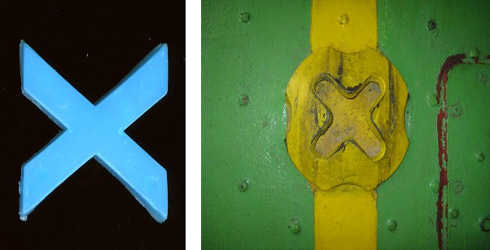
The Museum of (X) project, created for the 2010-11 ADM-HEA Teaching Fellowship, aimed to explore and identify the value of the collected object as a primary research method in the digital age. The project developed an online ‘museum’ that, as an archive of anything, provides an accessible forum for commonalities and specialist perspectives to be revealed across discipline boundaries, often through the same object/subject. The collection reorders and re-states everything about the cultural territory that can be observed and remembered, ‘thereby laying claim to (one’s own interpretation of) the universe’ (Wild, 2000).
The gathering, documentation and classification of the subject (the letter ‘X’) is based in the everyday because ‘design and the everyday are inextricably intertwined (Hunt, 2003), and as a method of facilitating engagement with a wider audience. As such, collecting can be viewed as a ‘mode of knowledge’ (Stewart, 2003) and a useful opportunity for critically analysing the subject as a multiple/variable in the cultural landscape. With the ADM-HEA’s support a simple design was developed and the technical support acquired to build the Museum of (X): an internally and externally facing website dedicated to collecting as creative practice. The site is envisioned as a university-wide forum for research and discussion situating contemporary design debate and practice in the digital realm. Collecting is applied here as a familiar, though tacit, method of informing design in relation to cognition of the subject and how the end user interprets this in context and form. According to Jean Baudrillard, for the child, collecting represents the most rudimentary way to exercise control over the outer world: by laying things out, grouping them, handling them. Comparing the virtual with the material is presented as a truly ‘interactive’ teaching and learning tool aiming to tackle issues of objecthood in the construction of meaning.
Through studio-based discussion and questionnaires, a cross-disciplinary community of collectors helped construct the Museum’s contents, identifying common ground and differences of discipline in relation to their subject. Taxonomical systems were introduced as devices for revealing new knowledge, while a self-reflective assessment of the process aims to encourage peer-led review and future collaboration. The project provides space to assess innovative and experimental forms of research and interpretation, as a processof critical analysis through the collected subject (X). The Museum’s site and its ideas, though initially envisioned within the loosely-defined territory of graphic design, are intended to be experienced within the broader art and design community.
For the designer, the raw material of the collection acts as a creative and conceptual ‘fuel’, informing practice as a means to an end and, sometimes, as an end in itself. The collection of graphic ephemera often acts as a process of trying to make sense of material culture giving ‘value to that which is commonly seen as having no value… a tendency familiar in graphic design’ (Blackwell, 1996). Close observation of a subject, object or place is, as Jacobs (1998) suggests, a process of ‘inhaling change’ from the world, then ‘exhaling’ back onto the page or screen. As a research methodology, collecting had been embedded in the curriculum of the BA Graphic Design programme at Kingston University for a number of years for just this reason. By introducing students to the close observation and handling of material knowledge in relation to an everyday object/subject, the collection has proved to be a valuable focus for the process of cognition and translation to be understood.
As a method of fully considering the role and content of the Museum a series of talks and feedback sessions were delivered with students across the university and at the Pairings conference in Manchester. Responses to questionnaires revealed a significant interest in collecting as a source of inspiration and understanding with subjects including ‘interesting pens’, ‘woodlice’ and ‘small things in big spaces’. Yet few respondents employed classification systems to aid interpretation: many collections were ‘bundled in boxes’ or kept ‘in a pot’ and only a few arranged the objects in order; in ‘order of prestige’, in the ‘order I bought them in’, ‘rarest from most common’ or by ‘size, colour and how much other people liked it’.
If classification is the mirror of collective humanity’s thoughts and perceptions, then collecting is its material embodiment. Collecting is classification lived, experienced in three dimensions. The social order is itself inherently collective: it thrives on classification, on rule, on labels, sets and systems (Elsner and Cardinal, 1994, p.2).
What became apparent from the feedback was the need for a taxonomical system in the online Museum of (X) to aid a more structured cognition of the collection for the viewer and collector, whether using a thematic or personal hierarchy. For instance, in a similar mode of practice to artists such as Christian Boltanski and Michael Landy, some students revealed: ‘I’m recording every red object I own as a (kind of) self-portrait’. The website (Figures 1a - 1c) employs Wurman’s (1990) LATCH system – Location, Alphabet, Time, Category and Hierarchy – to help analyse information on a subjective, emotive, scientific or conceptual basis.
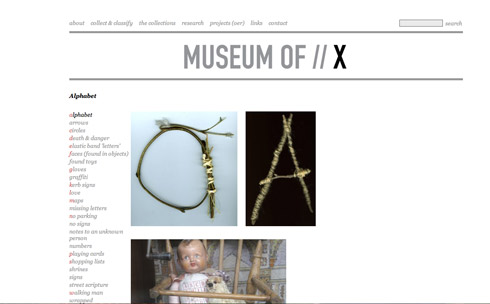
Figure 1a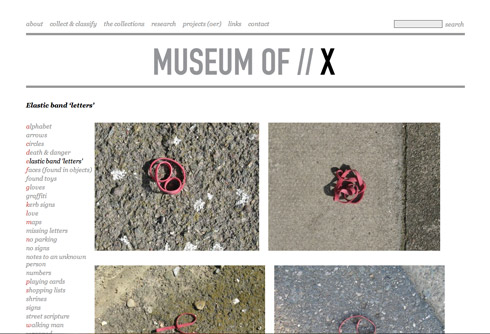
Figure 1b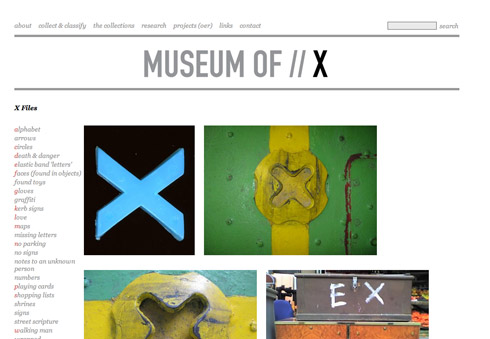
Figure 1c
The role of collecting in developing collaborative work was explored in the Pairings conference at which I was invited to give a couple of workshops. The workshops looked at naming as a mode of understanding collaboration through the collected object, drawing on the ideas of Foucault (2002). As a mode of re-envisioning partnerships across traditional subject boundaries the audience were invited to create new terms beyond the familiar ‘pride of lions’ or a ‘boogle of weasels’. Collective nouns were used as a playful way of creating identities for new collaborative practice (Figures 2a and 2b): the construction of new nouns became the creative exercise itself. Posters featuring diverse activities and professions from artists and contortionists to mind-benders and zoo-keepers were displayed as interactive suggestion boards.

Figure 2a
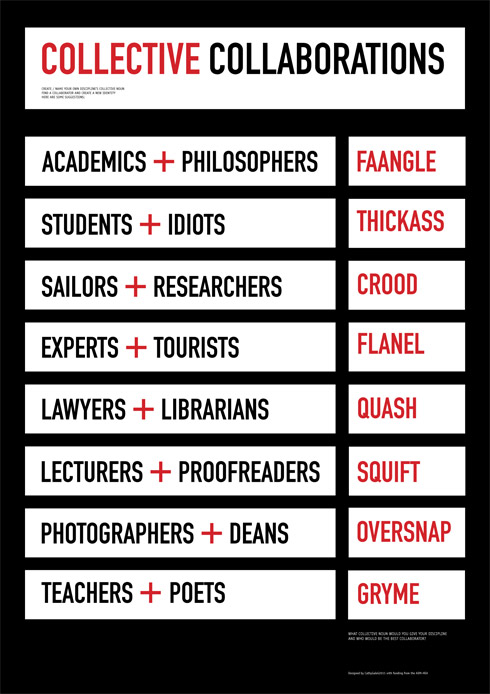
Figure 2b
What became evident was the attraction of the everyday collected object (Figure 3) as a means to support self-reflective analysis of the, often intuitive, creative process, thereby identifying and articulating its value with more conviction. The results of this conference and the informal talks and seminars given, provide the substance of the online museum, which is still a work-in-progress. As the curator and editor of the Museum of (X) contributions to the site will be managed by myself, but linked to Vimeo, YouTube and Flickr sites to allow widening participation and knowledge transfer. In this way the broader art and design community benefits: even with limited access to facilities anyone can partake with the project in some way.

Figure 3
The online Museum of (X) integrates collecting and classifying from students, staff and professionals and demonstrates the ongoing nature of the archive as a method of experiencing and understanding the world. The long-term intention is to enable ongoing (online) exchange of research methodologies across-disciplines through the shared activity of collecting, incorporating industry ideas and research processes to help build open-ended debate and stronger links for designers of the future.
As an extension of this teaching and learning model, I have linked the museum with the Open Education Resource. As such, schools and communities will be able to access sample projects and contribute their own archives to the site or via links. In this way the Museum of (X) aims to make a case for collecting as a problem-solving process, a method of valuing objects in material culture across cultures and communities. The website address is ‘live’ but incomplete at this time: its full life will begin when the author has completed her PhD, projected as at the end of June 2012.
Contact information
For information or ideas on contributions: c.gale@kingston.ac.uk
References
Blackwell, L. and Brody, N. (1996) G1 Subj.; Contemp.Design, Graphic, Lawrence King, London.
Elsner, J. and Cardinal, R. (Eds.) (1994) Cultures of Collecting, Reaktion Books Ltd, London.
Foucault, M. (2002, originally published 1989) The Order of Things, Routledge Classics, London).
Hunt, J. (2003) ‘Just Re-Do It: Tactical Formlessness and Everyday Consumption’in A. Blauvelt (2003) Strangely Familiar: Design and Everyday Life, Walker Art Centre, New York.
Jacobs, K. (1998) ‘Because: a short philosophical treatise on intuition’ in D. Carson, 2nd Sight, Lawrence King, London.
Stewart, S. (1993) On Longing. Narratives of the Miniature, the Gigantic, the Souvenir, the Collection, Duke University Press, London.
Wild, L. and Blackwell, L. (2000) Edward Fella: letters on America, Lawrence King, London.
Wurman, R. S. (1990) Information Anxiety, Doubleday, New York.
Images all supplied by Cathy Gale
Figures 1a - c: Screen grabs of Museum of X website
Figures 2a-b: Collective nouns were used as a playful way of creating identities for new collaborative practice
Figure 3: How do you collect? image
Header image: Section from Figure 1c


